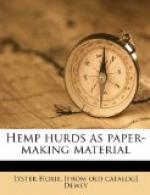=Proportion of hurds to fiber and yield per acre.=
[Illustration: Fig. 1.—Hemp-breaking machine. The stalks are fed sidewise in a continuous layer 2 to 3 inches thick, turning out about 4,000 pounds of clean fiber per day and five times as much hurds.]
The yield of hemp fiber varies from 400 to 2,500 pounds per acre, averaging 1,000 pounds under favorable conditions. The weight of hurds is about five times that of the fiber, or somewhat greater from hemp grown on peaty soils. A yield of 2-1/2 tons of hurds per acre may be taken as a fair average.
=Hurds available from machine-broken hemp.=
Hemp hurds are available only from hemp which is broken by machines, when the hurds may be collected in quantity in one place (figs. 1 and 2). Most of the hemp in Kentucky is still broken by hand brakes. These small brakes are moved from shock to shock, so that the hurds are scattered all over the field in small piles of less than 50 pounds each, and it is the common practice to set fire to them as soon as the brake is moved. It would be difficult to collect them at a cost which would permit their use for paper stock.
Where machine brakes are used, the hemp stalks are brought to the machine as grain is brought to a thrashing machine, and the hurds accumulate in large piles, being blown from the machine by wind stackers.
Machine brakes are used in Wisconsin, Indiana, Ohio, and California, but to only a limited extent in Kentucky. Five different kinds of machine brakes are now in actual use in this country, and still others are used in Europe. All of the best hemp in Italy, commanding the highest market price paid for any hemp, is broken by machines. The better machine brakes now in use in this country prepare the fiber better and much more rapidly than the hand brakes, and they will undoubtedly be used in all localities where hemp raising is introduced as a new industry. They may also be used in Kentucky when their cost is reduced to more reasonable rates, so that they may compete with the hand brake. Hemp-breaking machines are being improved and their use is increasing. The hemp-growing industry can increase in this country only as machine brakes are developed to prepare the fiber. A profitable use for the hurds will add an incentive to the use of the machine brake.
[Illustration: Fig. 2.—Machine brake and hemp hurds. Hemp hurds from machine brakes quickly accumulate in large piles.]
=Present uses of hemp hurds.=
Hemp hurds are used to a limited extent for barnyard litter and stable bedding, as a substitute for sawdust in packing ice, and, in rare instances, for fuel. They are not regarded as having a commercial value for any of these uses, though they are doubtless worth at least $1 per ton on the farm when used for stable bedding. They are a waste product, without value for other purposes which might compete with their use for paper stock.




